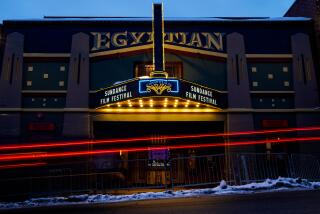Commerce, Not Art, the Game at Sundance : But Despite All the Sales Talk, It’s Still the Top U.S. Film Fest for Independents, Shorts
- Share via
PARK CITY, Utah — Steven Soderberg, whose “sex, lies, & videotape” was the toast of the 1989 Sundance Film Festival, is sitting in a corner of a typically overpacked party, grumbling about the “encroachment of commerce” eclipsing art at this important annual showcase for independent movies.
After flying in from his home in Virginia to help promote “Suture,” which he executive-produced, at this year’s festival, Soderberg takes a sip of beer and observes, at the risk of sounding arrogant: “Since 1989, it’s never been the same.”
At that time, when he emerged as one of the hottest young filmmakers around, Sundance “wasn’t overrun by agents--it hadn’t become a deal market, a sales place,” Soderberg says. The shift, he says, came in 1990 when “suddenly this festival became this feeding frenzy, and it was no longer about art.”
“Sex, lies,” made on a budget of $1.2 million, was the first breakout hit discovered at Sundance, grossing $25 million.
“That’s when everyone started taking this festival so seriously,” agrees Fine Line Pictures President Ira Deutchman over lunch at one of Hollywood’s favorite ski hangouts, the posh Stein Eriksen Lodge in neighboring Deer Valley. “The next year it was inundated with agents and studio executives.”
Deal makers traditionally descend on this picturesque mountain town during the second half of the 10-day January festival, their cellular phones popping up like mushrooms in the night. Competition for talent and films is so fierce that many contracts are signed weeks, even months, before Sundance begins. Business and schmoozing spill onto the streets, the ski slopes and into restaurants.
Not everyone is dismayed by that. Many filmmakers covet the attention they receive from Hollywood, foreign buyers and the national press, because it increases the likelihood of landing an agreement to get their movie into the marketplace. Just about anyone you ask here says the festival, run by Robert Redford’s Sundance Institute, is still the premier American film festival for independent features, documentaries and shorts.
Beth Swofford of the William Morris Agency, who signed two young filmmakers--Matty Rich (“Straight Out of Brooklyn”) and Richard Linklater (“Slackers”)--out of the festival three years ago, says agents track projects far in advance of Sundance and often sign talent at the script stage.
One agent left 2 1/2 days early this year “because 90%-95% of the people that made movies here were already signed. . . . If you haven’t seen the films before the festival, I’d say the ship has sailed by the time you get there.” The same holds for distributors looking for new movies to release.
“It’s much more competitive for those few films that distributors recognize have the right elements like the right marketing hook,” says Howard Cohen, head of acquisitions for the Samuel Goldwyn Co., which picked up the popular, edgy lesbian movie “Go Fish” early in the festival.
*
For all the intense deal making and schmoozing, however, Sundance also remains a haven for its original following of Hollywood wanna-bes, art-house intellectuals and plain old moviegoers--more than 6,000 of them this year.
It’s not unusual during the festival to overhear participants dissecting dolly shots, decrying commercialization of art or sharing production financing headaches inside Z Place, the perpetually buzzing festival headquarters. The conversations persist inside shuttle buses, where one driver had to break up a violent argument between two passengers over the merits of film violence.
Routine conversation is difficult at festival parties, which are so crowded that people can barely breathe or move, let alone speak. Even though the parties--largely hosted by film companies and agents and often held in exclusive condominiums--are by invitation, gate crashing is common.
Get-togethers take on a frat party-like atmosphere, as lines of young people stream up from restaurants and screenings to mingle into the morning hours. One of this year’s hot tickets was the Disney Channel’s Tuesday-night bash for “The Who’s ‘Tommy’: The Amazing Journey,” a documentary on the history of the rock opera. The party, held in a small condo, became so crowded that some people left early, fearing the wooden outdoor deck would collapse.
The next night, the two places to be were Deer Valley parties hosted by the Samuel Goldwyn Co. and the William Morris Agency/20th Century Fox. A caravan of Ford Explorers--the rental car of choice here--steadily made their way up to the mountainside bashes in the face of a heavy snowfall.
Miramax Films, which is distributing “Sirens,” hosted a classy sit-down dinner at one of the festival’s most popular restaurants, the Riverhorse Cafe, where journalists hobnobbed with “Sirens” stars Hugh Grant and Elle MacPherson and director-screenwriter John Duigan. A Sony Classics/ HBO-sponsored party with live music by Los Lobos evolved into a mob scene so intense that even an unhappy Danny DeVito reportedly couldn’t get in.
Publicity stunts are rare at Sundance. But one creative exception was a trail ride orchestrated by Clein + White to promote Arthur Elgort’s “Colorado Cowboy: The Bruce Ford Story,” about a renowned rodeo champion. (On Saturday night, the film won the festival’s award for best cinematography for a documentary.) Reporters followed Ford on horseback down a snowy and muddy trail through the scenic countryside outside Park City. Director Elgort, a former fashion photographer, revealed that he had never been on a horse, but said, “I don’t play the violin either, but someday I’d like to make a documentary about violinists.”
While people at Sundance are supposed to be above star-gazing, there was still plenty of buzz about which actors were spotted on crowded Main Street. Heavily clothed, but still-recognizable celebrities included Winona Ryder, Joan Chen, Tim Robbins, Eric Stoltz, Ethan Hawke, Fred Ward, Rob Morrow, Julie Delpy, MacPherson, Jeanne Tripplehorn, Mary Stuart Masterson, Matthew Modine (who has a short here and is on the jury), Andie MacDowell and Gena Rowlands, who was honored for her work in independent films.
Despite the frenzied nature of many events, there was little complaining.
“It’s a chance to hobnob with my fellow film wizards. I get much more done here than at the office,” says Paul Colichman, president of IRS Media.
Added David Guc of the Gersh Agency’s New York office: “Here, you’re introduced to people on a much more informal basis. You can make a deal with someone just because he likes your skiing. It’s a ski-schmooze-a-thon.”
Some movie executives, such as Triton Pictures’ owner Jonathan Dana, here on vacation, choose to come simply to get away from the grind of everyday Hollywood life. This year, Sundance was a particularly idyllic retreat for the earthquake-traumatized attendees from Los Angeles. As the festival drew to an end during the weekend, more than one Angeleno could be overheard saying wistfully, “I don’t want to go home.”
More to Read
The biggest entertainment stories
Get our big stories about Hollywood, film, television, music, arts, culture and more right in your inbox as soon as they publish.
You may occasionally receive promotional content from the Los Angeles Times.










